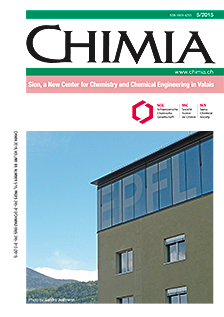Surface Reactions are Crucial for Energy Storage
DOI:
https://doi.org/10.2533/chimia.2015.269Keywords:
Co2 reduction, Energy storage, Hydrogen, Spectroscopy, Surface reactionsAbstract
Reactions between gas molecules, e.g. H2 and CO2 and solids take place at the surface. The electronic states and the local geometry of the atomic arrangement determine the energy of the adsorbate, i.e. the initial molecule and the transition state. Here we review our research to identify the surface species, their chemical state and orientation, the interaction with the neighbouring molecules and the mobility of the adsorbed species and complement the experimental results with thermodynamic modelling. The role of the Ti was found to be a bridge between the charged species preventing the individual movement of the ions including charge separation. The Ti has no catalytic effect on the hydrogen sorption reaction in borohydrides. The physisorption of molecular hydrogen is too weak at ambient temperature to reach a significant hydrogen storage density. The addition of a hydrogen dissociation catalyst to a nanoporous material with a large specific surface area may potentially enable the spillover of hydrogen atoms from the metal catalyst to the surface of the porous material and chemisorb on specific sites with a much higher binding energy compared to physisorption. The intercalation of alkali metals in C60 fullerenes increases the interaction energy of hydrogen with the so-called metal fullerides significantly. Sterical diffusion barriers by partial oxidation of the surface of borohydrides turned out to redirect the reaction path towards pure hydrogen desorption and suppress the formation of diborane, a by-product of the hydrogen evolution reaction from borohydrides previously undetected. The combination of a newly developed gas controlling system with microreactors allows us to investigate complex reactions with small quantities of nano designed new catalytic materials. Furthermore, tip-enhanced Raman spectroscopy (TERS) will allow the investigation of the reactions locally on the surface of the catalyst and the near ambient pressure photoelectron spectroscopy enables analysis of the surfaces in ultra-high vacuum and in situ interaction with the adsorbates i.e. while the reaction takes place. This brings us in a unique position for the investigation of the heterogeneous reactive systems. The mechanism of the Ti catalysed hydrogen sorption reactions in alanates was recently established based on spectroscopic investigations combined with thermodynamic analysis of the transition states.Downloads
Published
2015-05-27
Issue
Section
Scientific Articles
License
Copyright (c) 2015 Swiss Chemical Society

This work is licensed under a Creative Commons Attribution-NonCommercial 4.0 International License.
How to Cite
[1]
Chimia 2015, 69, 269, DOI: 10.2533/chimia.2015.269.







